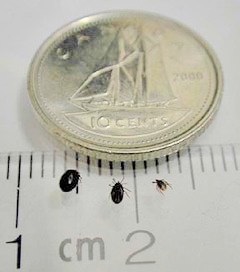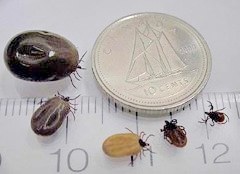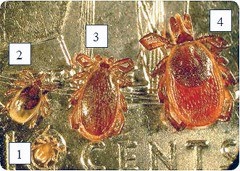
Rouge Valley Conservation Centre

To donate to the Rouge Valley Conservation Centre click on the button below:
Kids Programs
Special Events
Donate
About Us
Ticks in the Rouge
Please note, there are ticks in the Rouge and some may carry Lyme Disease. Please make sure that you are taking the necessary precautions before you go out on the trails. Ticks have been in the Rouge for some time and they are actually everywhere, not just here (e.g. other Parks, Playgrounds and Backyards). Ticks are just a new reality of outdoor space in Ontario. Ticks do not fly or jump. They tend to "hang" on long grasses waiting to attach on to a passing animal or human. Some ticks can be found in leaf litter as well. Ticks are more likely to be found off trail where deer, mice and other animals roam as they are the main modes of transportation for the ticks. There is nothing we can do about the ticks in the park. But you can protect yourself:
-
•Do not walk off trail, stay in the centre of the trail. Do not touch long grasses or plants. Some ticks can also be found in leaf litter.
-
•Keep dogs on leash and on the trail. This is not only important because of the ticks but because there are a lot of sensitive plant and animal species here in the Rouge as well as ground nesting birds and animals.
-
•Wear light coloured clothes consisting of long pants, long socks and long sleeves. Leggings or tight fitting pants are not recommended; hiking pants or loose legged pants are recommended. Tuck your shirt into your pants, and pull your socks over your pant legs.
-
•Wear running shoes or boots (no sandals, crocs or shoes with holes), a hat and bug spray with DEET or Icaridin on your skin and clothing (always follow the directions on the label
Before you get in the car or leave the park:
-
•When you are finished your hike, check your clothes, hats, shoes, face, hair etc. for ticks.
-
•Check children, dogs, outdoor gear and bags for ticks as well.
When you get home:
-
•Put dry outdoor clothes in a dryer on high heat for 10 minutes to kill any remaining ticks. If your clothes are damp, additional drying time is needed. If you need to wash your clothes first, hot water is recommended. If the clothes cannot be washed in hot water, tumble dry on low heat for 90 minutes or high heat for 60 minutes. (check clothing labels before doing this)
-
•Do a full-body check for ticks on yourself and your children, especially in the hair, under the arms, in and around the ears, inside the belly button, behind the knees, between the legs and around the waist
-
•Shower or bathe and wash your hair within two hours of being outdoors to facilitate a prompt tick check and to remove ticks that have not attached yet
-
•If you find an attached tick, remove it with tweezers immediately. Removing it within 24-36 hours can help prevent infection. Follow proper removal procedures.
If you do find a tick, remove it following proper guidelines or go to the doctor to remove it. Make sure that you read up on how to properly remove a tick if you do it yourself. Keep the tick in a bottle and send it in to Toronto Health to have it checked for Lyme Disease. Ticks can take up to 24 or 36 hours to "bite" so it is important to shower and wash your clothes as well as do a tick check when you get home.
For official information about ticks you can check out the following government websites:
https://www.toronto.ca/community-people/health-wellness-care/health-programs-advice/lyme-disease/
https://www.ontario.ca/page/lyme-disease
https://www.canada.ca/en/health-canada/services/pest-control-tips/blacklegged-deer-ticks.html
https://www.canada.ca/en/public-health/services/diseases/lyme-disease.html
https://www.canada.ca/en/public-health/services/diseases/lyme-disease/prevention-lyme-disease.html
https://canlyme.com/lyme-basics/tick-id/
Please note:
We are not the managers, property owners or operators of Rouge Park. We are a non-profit charity located here in the Rouge.
For complaints, concerns and questions about ticks please contact the City of Toronto Parks Department or Parks Canada (Owner and Manager).



The following photos have been taken from https://www.canada.ca/en/health-canada/services/pest-control-tips/blacklegged-deer-ticks.html and show the Black Legged Tick in different forms.
Three nymphs of the blacklegged tick are shown in different stages of feeding.
5 female blacklegged ticks in different stages of feeding
Life stages of a blacklegged tick that has not fed
Rouge Valley Conservation Centre © 1995 – 2018 All rights reserved
